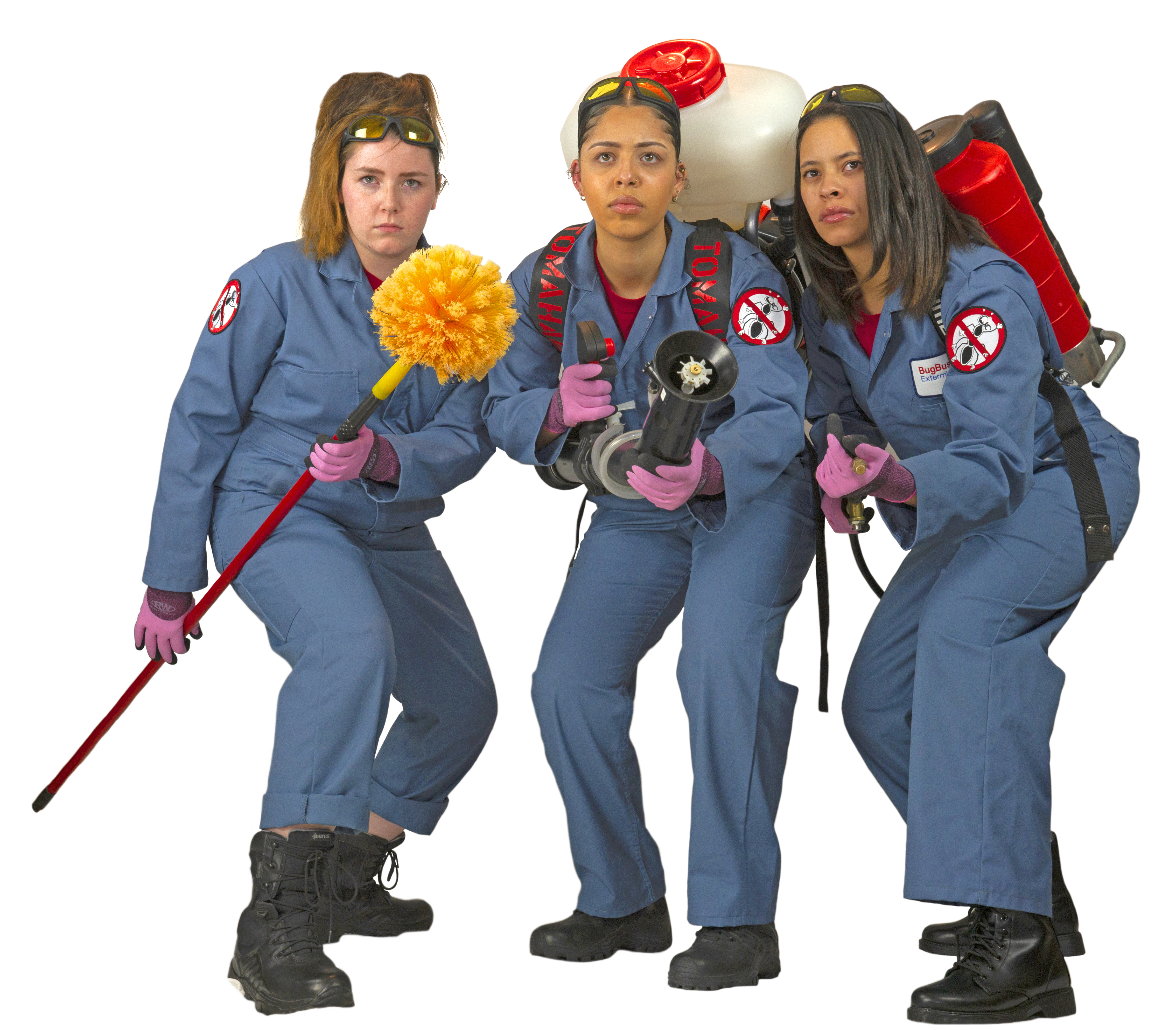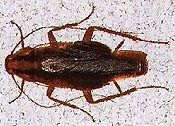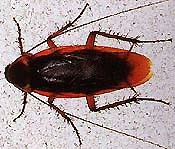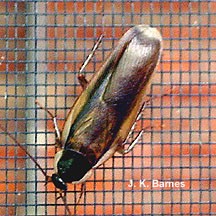
Serving Southwest Ohio and Northern Kentucky

info@TheBugBusters.net.
Attention Realtors and Loan Officers: Click the link for our online inspection sheet.
About Cockroaches
Cockroach
Cockroaches are among the most common insects. Some biologists consider insects to be one of the most successful groups of animals to ever inhabit this planet, and cockroaches are one of the most adaptable and successful insect groups. They have been able to survive many changing environments over millions of years. There are approximately 3500 species of cockroaches worldwide. About 60 species are found in the United States. Their presence in nearly every part of the world and wide range of habitats demonstrate that cockroaches are truly an outstanding success story in nature. Unfortunately, many of the same outstanding biological characteristics which make them so successful, also make them one of the most difficult pests to manage.
Only a few of the cockroach species found in the United States routinely enter and infest our dwellings. The most common of these are the German cockroach, American cockroach (also known as water bug), Oriental cockroach, Brown-banded cockroach and Woods cockroach. These five species represent 95% of all cockroach management in and around buildings. In some parts of the U.S., one species may be more prevalent than another. Certain other species may infest homes or other buildings but will generally be found in much more localized situations or under other unusual circumstances.
Most cockroaches are tropical and sub-tropical in origin, generally living outdoors. They are mostly active at night, during which time they forage for food, water, and mates. If they are active during the day, it usually means there is a large population or some other form of stress (such as lack of food or water). Cockroaches ordinarily prefer a moist environment, and many species also prefer a relatively high degree of warmth. However, cockroaches living in buildings are mostly scavengers and feed on a wide variety of food. They are especially fond of starches, sweets, grease, and meat products; but will also eat a great variety of materials such as cheese, beer, leather, bakery products, starch in book bindings, glue, hair, flakes of dried skin, dead animals, and plant materials.
Cockroaches usually choose to live in cracks and crevices which provide a warm and humid environment. Some species, such as the American and oriental, gather in large groups on open walls in protected places or in open areas outside. While they are often found in groups in their daytime hiding or resting areas (called "harborage"), and can be found feeding in groups at night, cockroaches are not social insects like ants and wasps. Cockroaches generally are omnivores (eat everything) and forage individually for food.
The general shape of a cockroach is familiar to everyone. They are oval and flat-bodied, which enables them to squeeze into all types of cracks and crevices. A pronotum (a shield-like covering) projects forward over the head; their mouthparts are of the chewing type and are oriented downward slightly toward the rear of their body. With their long spiny legs, they can run rapidly over most surfaces. Specialized pads in their tarsi allow them to easily scale glass windows or walk on a ceiling.
Besides their ability to move around inside and outside, and some species are good fliers, cockroaches are well known for moving to new areas via "hitchhiking." Because they prefer to hide in cracks and crevices in the daytime, they are frequently moved about by individual people or in products shipped around cities or the country. Careful inspection of groceries, furniture, clothing, or other goods coming into a home or other facility may reveal cockroaches hiding in these items. Careful observations by pest management professionals and researchers have shown surprising numbers of German cockroaches entering such facilities as hospitals, restaurants, zoos, and supermarkets by these routes.
Some of the most common types of cockroaches located in our region are:
German Cockroach: The German cockroach is the most common species found in houses, apartments, restaurants, hotels, and other institutions. Adults are pale to medium brown and about 1/2-to 5/8-inch long. German cockroaches can be distinguished from other roaches by the two dark stripes on the back of their head. The German cockroach is a general feeder but is particularly attracted to fermented foods and beverage residues (e.g., beer spills). If water is present, adults can live about a month without food, but young nymphs will die of starvation within 10 days. Without food or water, the adults die in less than two weeks. Most stages become very stressed if deprived of food or water for more than a couple of days. Stressed cockroaches tend to wander or forage for resources aggressively, even during abnormal periods such as the daytime.
Infestations are sometimes found in areas not generally suspected of German cockroaches, for example, dresser drawers in bedrooms. When German cockroaches are found scattered through non-food areas of a home or building, it is usually caused by a very heavy infestation or by the repellent effects of insecticide applications. Cockroaches in these areas will find food scarce, but can feed on scattered crumbs, soiled clothing, and the glue on dresser drawers or on some cosmetic products. German cockroaches can also be found outdoors during warm months, often associated with garbage receptacles. This, too, is usually due to a heavy infestation indoors
Adult German Cockroach

American Cockroach:
The American cockroach is also known as the water bug, flying water bug and, in some areas of the South, the palmetto bug. It is the largest of the common species, growing to 1.5 inches or more in length. It is reddish-brown, with a pale brown or yellow border on the upper surface of the pronotum (region directly behind the head). Both the male and female are fully winged.
When indoors, the American cockroach is found in dark, moist areas of basements and crawl spaces as well as in and around bathtubs, clothes hampers, floor drains, pipe chases and sewers. In basements they are usually found in corner areas high on the walls. The American cockroach is also common around the manholes of sewers, and on the underside of metal covers of large sump pumps in boiler rooms. American cockroaches have also been observed migrating from one building to another during warm months.
American cockroaches feed on a variety of foods, but decaying organic matter seems to be preferred. They also feed upon book bindings, manuscripts, clothing, and glossy paper with starch sizing. Syrup and other sweets are also attractive. The adults can survive two or three months without food, but only about a month without water.
Adult American Cockroach

Woods Cockroach:
The term woods cockroach covers several cockroach species, usually of the same genus and having similar habits. The species most generally described is the Pennsylvania woods cockroach. Woods cockroaches are small, usually not more than 2/3 of an inch long. Adults are dark brown with the sides of the thorax and the front half of the wings margined with yellow. The Pennsylvania woods cockroach is widely distributed in the eastern, southern and Midwestern states.
These cockroaches often become a problem when infested firewood is brought indoors. They will wander about the house without congregating in any room. They can be especially troublesome during the mating season which is often May and June. Male woods cockroaches are strong fliers and will come from considerable distances, often in large numbers. They are readily attracted to lights at night, and accidentally gain entry indoors. Large numbers may also be found in the rain gutters of homes. Woods cockroaches feed primarily on decaying organic matter.
Adult Woods Cockroach

BugBusters strongly recommends that at the first sighting of any of the above cockroaches, you contact us to schedule an appointment for treatment. This is a pest that you do not want to establish residency in your home or workplace. We also recommend monthly service for any location with a high volume of people interactions such as churches, schools, offices and especially restaurants and food handling facilities.
Dayton, OH 45401-3151
Phone 937-256-6475
info@TheBugBusters.net
Powered by w3.css